栅栏上的铁丝网和国民警卫队周二仍部署在国会山萦绕心头的提醒1月6日造成140名警察受伤,5人死亡的致命袭击。
袭击的余波仍在继续,因为参议院举行了第一次安全失败公开会议,这是国土安全与政府事务委员会和参议院规则与行政委员会联合调查的一部分。
1月6日,负责国会大厦安全的高级官员作证,其中三人——前美国国会大厦警察局局长史蒂文·桑德、前参议院军士长迈克尔·斯坦格和前众议院军士长保罗·欧文——在袭击发生后立即辞职。
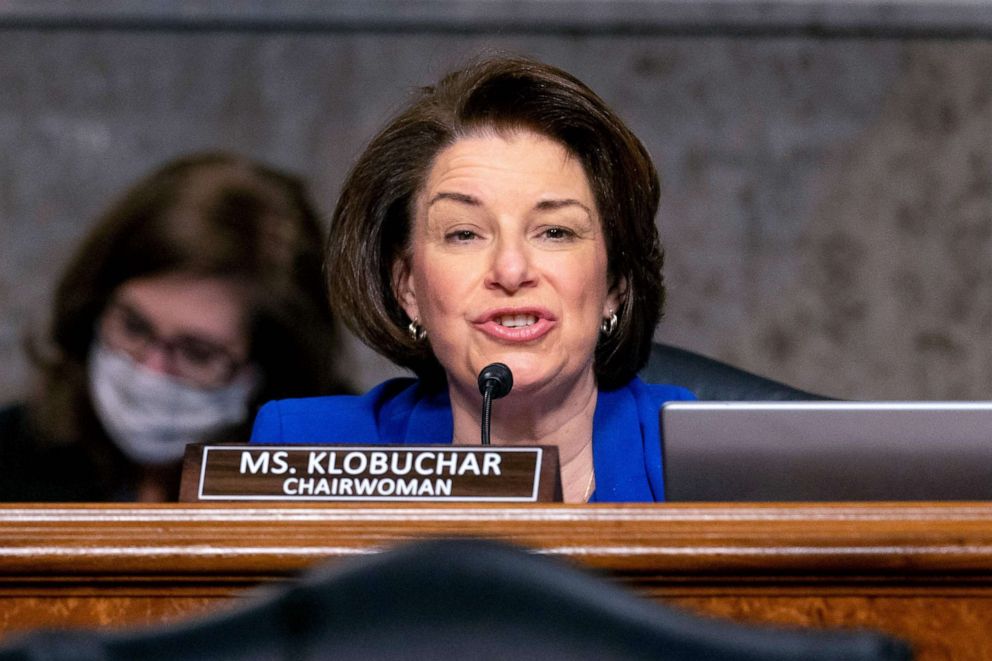
安德鲁·哈尔尼克/法新社通过盖蒂图像
女主席艾米·克洛布查尔在参议院国土安全和政府会议开始时发言
伦敦警察局代理局长罗伯特·孔戴也作证。他的机构为国会安全部队提供后援覆盖被支持特朗普的暴徒。
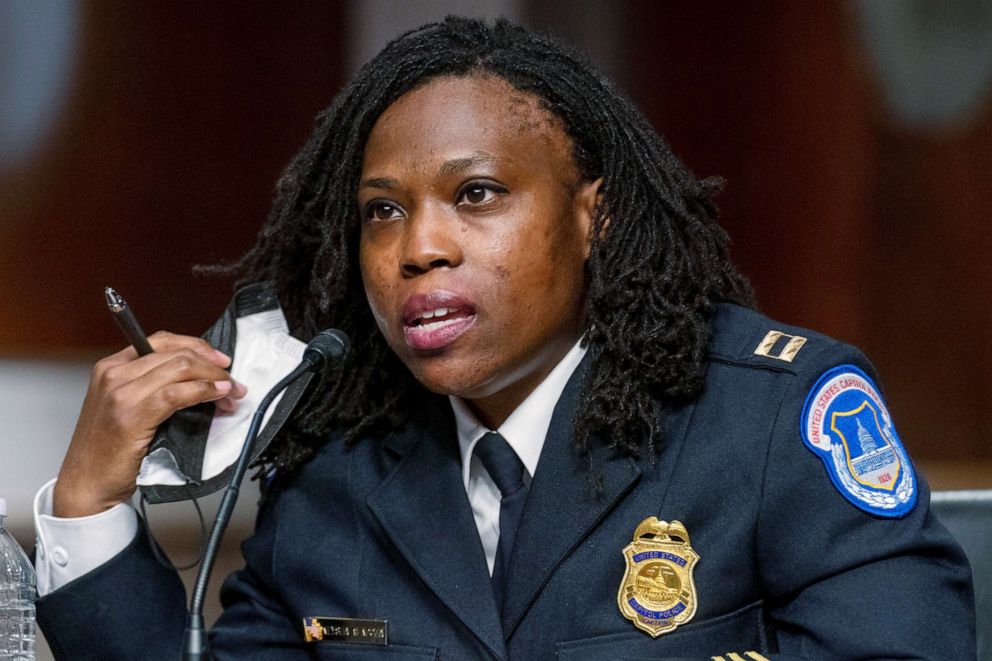
安德鲁·哈尔尼克/美联社
卡内沙·门多萨上尉在参议院国土安全和政府会议上讲话
然而,第一个证人是国会警察队长卡尼沙·门多萨,他对袭击的残酷进行了第一手描述。
门多萨告诉立法者,当她到达现场时,作为一名退伍军人,她立即注意到一种浓烟状的残留物,她认为这是军用级的CS气体。“暴徒们继续在圆形大厅部署CS。官员们受到了大量的气体暴露,这在建筑内部比在外部更糟糕,因为它无处可去。我的脸被化学烧伤,至今仍未痊愈,”她说。
她说,她在这场战斗中投入了将近4个小时,即使国会警察的人数是警察的10倍,他们也会被击败。
“作为一名美国人和一名退伍军人,看到我们遭到同胞的攻击,我感到很难过。看到不必要的生命损失,我很难过。我很难过看到这对国会警察的影响。我很难过看到这对我们的机构和我们的国家造成的影响,”她说。
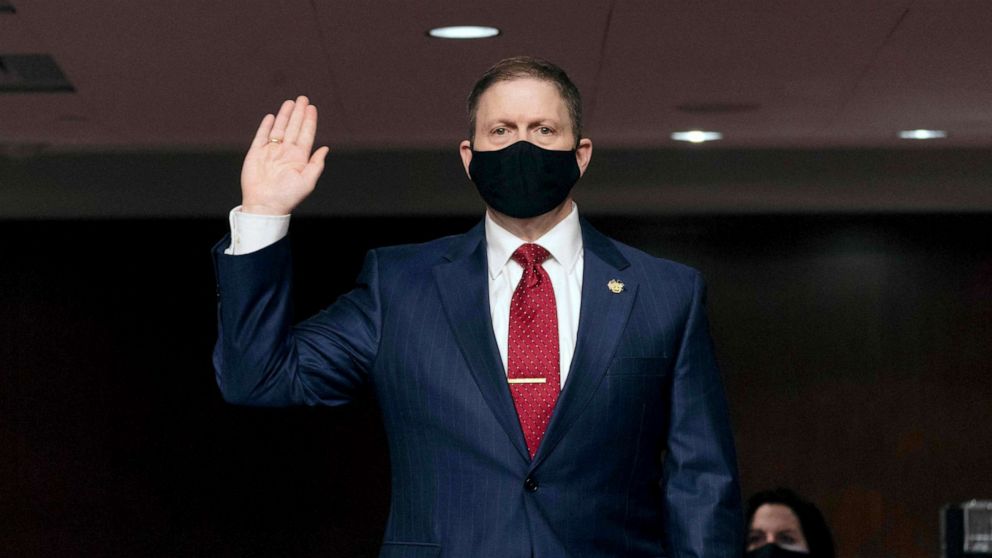
安德鲁·哈尔尼克/法新社通过盖蒂图像
前国会警察局长史蒂文·桑德在参议院国土安全部和戈夫面前宣誓就职
在她发言后,国会安全官员为他们的行为辩护,并在其他地方指责,但同意攻击是有计划的。
在开幕词中,桑德称对国会大厦的袭击是他30年职业生涯中见过的“对执法和我们民主的最严重袭击”,并指责各联邦机构准备不足,而不是国会警察。
“根据我们收到的情报,我们计划在国会大厦增加暴力活动,一些参与者可能携带武器。但我们收到的情报都没有预测到实际发生了什么,”桑德说。
这位前局长表示,在骚乱发生前,“广泛”的准备工作已经到位,包括“与我们的联邦和地方合作伙伴以及部门官员分享情报和信息,实施对议员保护的重大增强措施,制定广泛的行动增强措施,包括在国会大楼周围和内部增加派驻官员,进行重大的非暴力反抗部署,扩大周界,以及为官员分发额外的保护设备。”
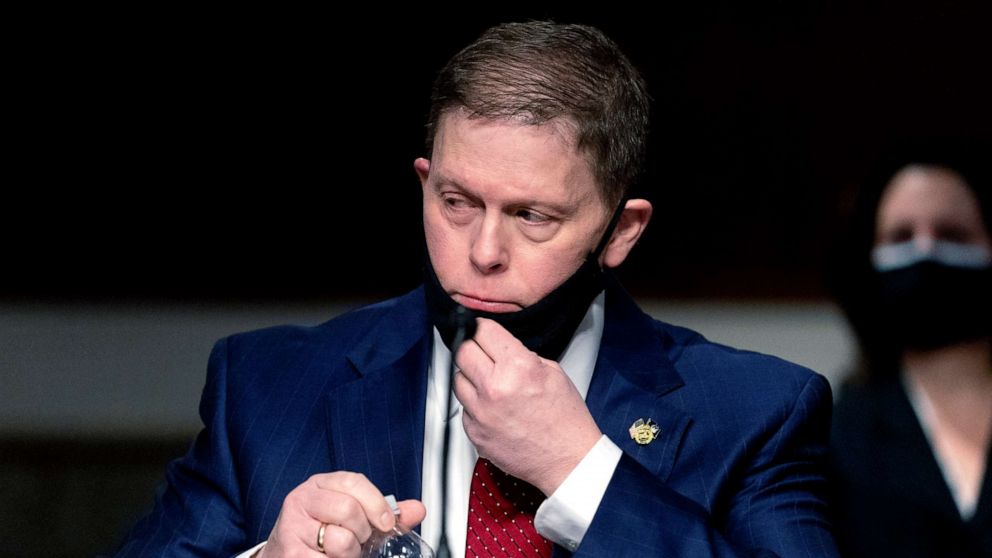
安德鲁·哈尔尼克/盖蒂影像公司
前国会警察局长史蒂文·桑德来到参议院国土安全部作证
桑德说,最迟在1月5日,包括联邦调查局在内的高级情报官员举行了一次会议,他们没有提供新的情报。
国土安全委员会主席加里·彼得斯(Gary Peters)强调了沟通失败的问题,他向Sund询问了《华盛顿邮报》的一篇报道,该报道称,“联邦调查局诺福克外地办事处1月5日发布了一份威胁报告,详细说明了与1月6日有关的网上暴力呼吁,包括抗议者,引用“准备战斗”,引用“结束引用”,引用“准备开战”,引用“结束引用”。
桑德作证说,他从未见过威胁警告电子邮件,他说这封邮件在袭击前一天晚上给了联合恐怖主义特遣部队的一名官员,他是在周一才知道的。参众两院的军士说他们也没有收到邮件。
桑德说:“我们为可能发生暴力的大规模示威做了适当的规划,但我们得到的是对我的军官的军事式的协同攻击和对国会大厦的暴力接管。”
前参议院军士长斯坦格(Stenger)首次公开发言,他在开场白中表示,华盛顿特区是该地区执法的“独特环境”,并表示应该对一切进行审查。
“有机会从1月6日的事件中吸取教训。应考虑对看似专业煽动者的资金和旅行进行调查。第一修正案的权利应始终结合专业调查来考虑,”他说。
孔戴在开场白中指出,他的警察被禁止在国会大厦逮捕人,但根据以前的示威经验,他们知道暴力是可能的。他也明确表示,MPD情报没有预测1月6日发生的事情。
"该地区没有情报表明国会大厦遭到了协同攻击。"
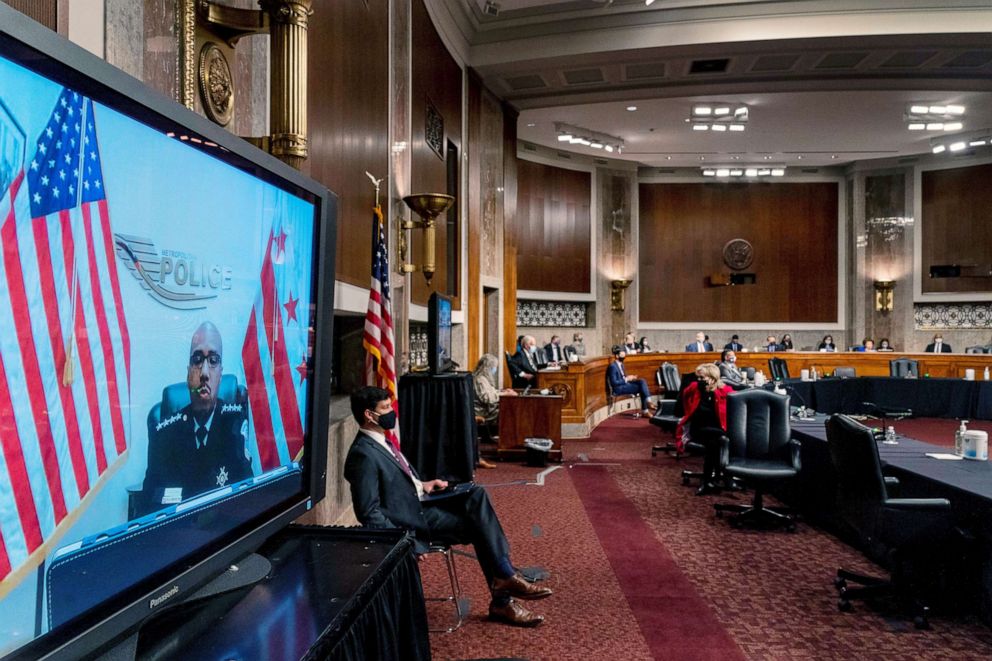
安德鲁·哈尔尼克/路透社
华盛顿警察局代理局长罗伯特·孔戴三世通过电话作证
孔戴指出,前一天在民主党全国委员会和共和党全国委员会总部附近发现了管状炸弹。他说,当他们在1月6日做出回应时,他的部门有四个目标:阻止暴徒,确保周边安全,允许国会恢复业务和逮捕。
他说,他对美国军队的回应“感到震惊”,称军方官员“不愿意将华盛顿特区国民警卫队派往国会大厦”
“虽然我当然理解规划和公众感知的重要性——员工在电话中提到的因素——但当你看到你的员工遭到殴打时,这些问题就变得次要了,因为暴民的数量远远超过你,”他说。
孔戴说,他对军队没有更快同意部署国民警卫队感到“震惊”。
他说:“陆军参谋回答说,他们不是拒绝派遣他们,而是想知道计划,不喜欢国会大厦地面上靴子的光学效果。”
五角大楼官员对他的描述提出质疑,并表示这一请求得到了适当的处理。
在开幕词中,前众议院武装中士欧文(Irving)也首次公开发言,他告诉议员们,1月4日,他与桑德(Sund)和斯坦格(Stenger)讨论了使用125名手无寸铁的国民警卫队士兵在国会大厦附近执行交通任务,以释放国会警察。
欧文说,“光学”的想法并没有在他事先不在国会大厦驻扎国民警卫队的决定中发挥作用,他说他收到的情报并不证明这一点。
“让我明确一点,媒体描述的光学在我的安全决策中没有任何作用。任何相反的暗示都是错误的。在制定1月6日的安全计划时,安全总是最重要的。欧文说:“我们确实讨论了情报是否证明在国会大厦驻军是正当的,我们当时的集体判断是否定的——情报没有证明。”
当共和党参议员罗伊·布朗特(Roy Blunt)询问欧文关于他的声明时,出现了一场关于一个关键点的争议——当时要求国民警卫队(National Guard)提供援助。欧文说,他一接到桑德的要求,就批准了援助。
“桑德先生说他在1:09请求国民警卫队的帮助,你批准了——是在2:10批准的。为什么在那个危机时刻,你要花一个小时批准国民警卫队的援助?”
“参议员,根据我的记忆,直到下午2点后不久,我才收到国民警卫队的批准请求,”欧文回答。
“好吧。“让我弄清楚,”布朗特回答道桑德先生,你知道你什么时候请求国民警卫队援助的吗?是下午1:09还是2:00?"
“是1:09,先生,”桑德回答。
“先生,我不记得当时的谈话,”欧文然后告诉布朗特。"在选举团会议期间,我在场。"
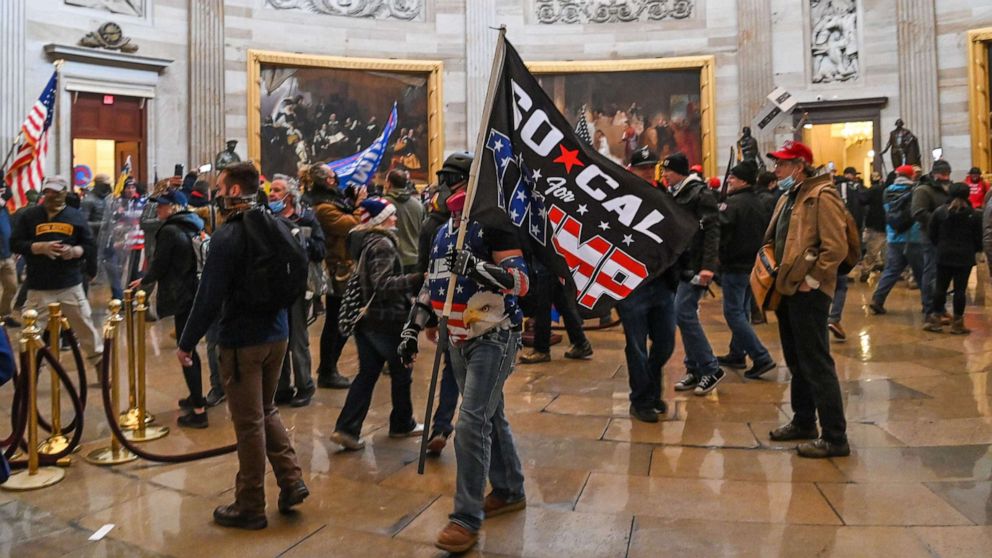
索尔·勒布/法新社通过盖蒂图像
唐纳德·特朗普总统的支持者在入侵国会大厦后漫步在国会大厦圆形大厅
议员们表示,他们将利用听证会来决定华盛顿未来需要什么样的安全措施。
委员会主席明尼苏达州参议员艾米·克洛布查尔(Sens. Amy Klobuchar)和密歇根州参议员彼得斯(Peters D-Mich)表示,另一场听证会将包括国防部、联邦调查局(FBI)、国土安全部(Homeland Security)和其他机构的代表。两党议员都表示,他们希望防止类似围攻的事件再次发生。
本月早些时候,美国广播公司新闻获得了Sund发送的一封信的副本,他说,导致这一事件的情报并没有表明它会变得像现在这样暴力。
桑德写道:“完美的后知后觉并不能改变这样一个事实,即我们的集体经验或情报——包括联邦调查局、特勤局、国土安全部(DHS)和哥伦比亚特区大都会警察局(MPD)提供的情报——都没有表明1月6日可能会发生协调良好的武装袭击国会大厦的事件。”。
他在信中写道,情报官员表示,1月6日将与此前11月和12月大多和平的选举后示威相似。
桑德说,他指示国会警察让所有宣誓就职的官员都工作,并启动了七个民间骚乱小组,其中包括大约250名官员。其中四个排配备了头盔、防护服和盾牌。
他说,1月5日,Sund主持了一个虚拟会议,重点是1月6日的活动以及就职典礼。桑德写道:“在会议期间,包括联邦调查局在内的任何实体都没有提供任何情报,表明数千名装备精良的武装叛乱分子将对美国国会大厦进行协调一致的暴力袭击。”。
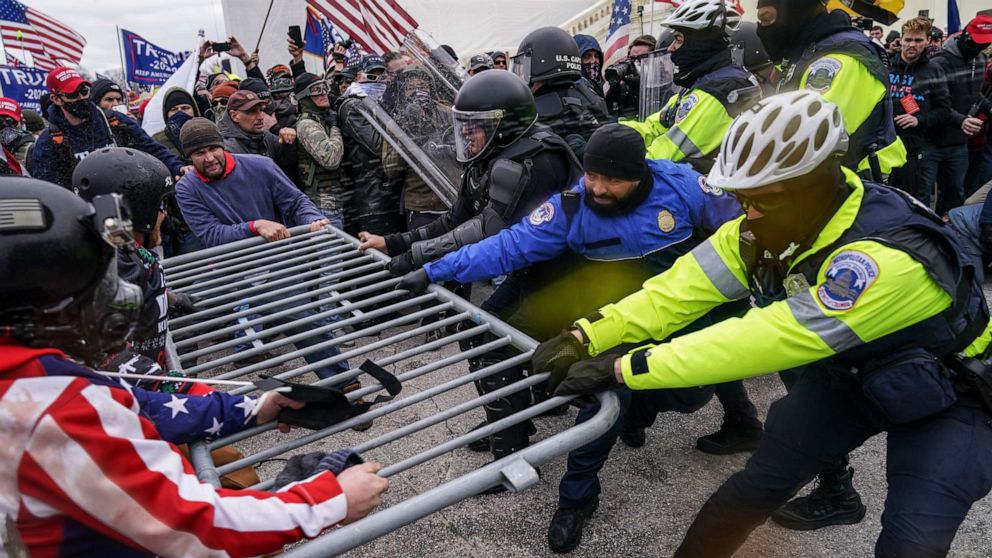
约翰·明奇洛/美联社档案
忠于唐纳德·特朗普总统的暴力叛乱分子试图突破警方的障碍
“毫无疑问,导致1月6日事件的情报收集和安全准备工作,以及袭击发生后的协调和应对工作都出现了巨大的故障。”彼得斯说。
在开场白中,参议院国土安全和政府事务委员会的高级成员、俄亥俄州参议员罗布·波特曼想起了国会警察霍华德·利本古德,他在几天后自杀身亡。“没有任何一名警官比他更致力于国会山警察局的使命,以及服务和保护的职责。我很自豪地称他为朋友,”波特曼说。
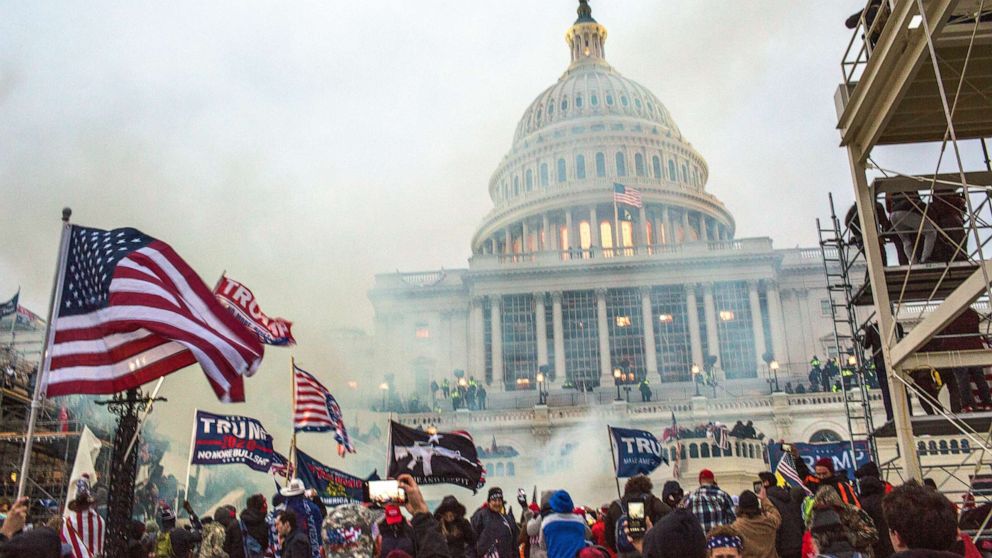
普罗巴尔·拉希德/光火箭通过盖蒂图像,文件
美国总统唐纳德·特朗普的支持者突破后,安全部队用催泪瓦斯回应
波特曼补充说,他想知道为什么“国会大厦在几个小时内就被占领了,我们需要知道国会大厦警察是否得到了适当的培训和装备来应对国会大厦的袭击,如果没有,为什么不呢?我们需要知道为什么国会大厦本身如此脆弱和不安全,以至于它很容易被破坏。”
听证会结束时,克洛布查尔抨击了所有相关人员,称美国联邦调查局(FBI)的警告导致情报和通信中断,“国会警察委员会(Capitol Police Board)和国防部(Department of Defense)都推迟了向国民警卫队(National Guard)提供援助的请求”。事实上,当局长试图获得一些紧急批准时,武装军士集中精力保护两院议员的安全。对我来说,你可以指指点点,但你也可以把这看作是一个没有为危机做好准备的过程。”
Senate holds 1st public hearing into Capitol assault security failures
Razor wire on fencing and National Guard troops still deployed on Capitol Hill on Tuesday arehaunting remindersof the deadly assault on Jan. 6 that left 140 police officers injured and five people dead.
The fallout from the attack continued as the Senate held the first public meeting into security failures as part of a joint investigation by the Homeland Security and Governmental Affairs Committee and the Senate Rules and Administration Committee.
Top officials responsible for security at the Capitol on Jan. 6 testified and three of them -- former U.S. Capitol Police Chief Steven Sund, former Senate Sergeant at Arms Michael Stenger and former House Sergeant at Arms Paul Irving, -- resigned in the immediate wake of the attack.
Also testifying was the Metropolitan Police Department's acting chief, Robert Contee. His agency provided backup for the Capitol security force that wasoverrunby the pro-Trump mob.
The first witness, though, was Capitol Police Capt. Carneysha Mendoza, who gave a first-hand account about the brutality of the assault.
When she arrived at the scene, Mendoza told lawmakers, she immediately noticed, as a military veteran, a heavy smoke-like residue that she identified as military-grade CS gas. "The rioters continued to deploy CS into the Rotunda. Officers received a lot of gas exposure, which is worse inside of the building rather than outside because there is nowhere it could go. I have received chemical burns to my face that still have not healed to this day," she said.
She said she was in engaged in the battle for almost four hours and that even if Capitol Police had 10 times the number of officers, they would have been overmatched.
“As an American and as an Army veteran, it is sad to see us attacked by our fellow citizens. I'm sad to see the unnecessary loss of life. I'm sad to see the impact this has had on Capitol Police officers. And I'm sad to see the impact this has had on our agency and on our country," she said.
After she spoke, the Capitol security officials defended their actions and pointed fingers elsewhere but agreed the attack was planned.
In his opening statement, Sund called the attack on the Capitol "the worst attack on law enforcement and our democracy" that he’s seen in his 30-year-career and laid blame on various federal agencies for poor preparation, not the Capitol Police.
"Based on the intelligence that we received, we planned for an increased level of violence at the Capitol and that some participants may be armed. But none of the intelligence we received, predicted what actually occurred," Sund said.
The former chief said that "extensive" preparations were put in place ahead of the riot, including "intelligence and information sharing with our federal and local partners, and department officials, implementing significant enhancements for Member protection, the development of extensive operational enhancements to include the additional posting of officers around and inside the congressional buildings, a significant civil disobedience deployment, and an expanded perimeter, and the distribution of additional protective equipment for the officers."
Sund said as late as Jan. 5 there was a meeting with top intelligence officials including the FBI – and they provided no new intelligence.
Homeland Security Committee Chairman Gary Peters, highlighting communication failures, asked Sund about a Washington Post account that "the FBI Norfolk field office issued a threat report on January 5th that detailed specific calls for violence online in connection with January 6th, including that protesters, quote, 'be ready to fight,' end quote, and, quote, 'go there ready for war,' end quote."
Sund testified he never saw the threat warning email, which he said had gone to an officer on the joint terrorism task force the night before the assault and that he learned of it only on Monday. The House and Senate sergeants at arms said did not get the email either.
"We properly planned for a mass demonstration with possible violence, what we got was a military-style coordinated assault on my officers and the violent takeover of the Capitol building," Sund said.
Stenger, the former Senate sergeant at arms, speaking publicly for the first time, said in his opening remarks that Washington, D.C., is a "unique environment" for law enforcement in the region and said everything should be reviewed.
"There is an opportunity to learn lessons from the events of January 6th. Investigations should be considered as to funding and travel of what appears to be professional agitators. First Amendment rights should always be considered in conjunction with professional investigations," he said.
Contee, in his opening remarks, noted that his police officers are barred from making arrests on Capitol grounds but based on the experience of prior demonstrations they knew violence was a possibility. He, too, made clear that MPD intelligence did not predict what occurred on Jan. 6.
"The District did not have intelligence pointing to a coordinated assault on the Capitol."
Contee noted pipe bombs were found outside of the Democratic National Committee and Republican National Committee headquarters nearby the day before. He said his department had four objectives when they responded on Jan. 6: stopping rioters, securing the perimeter, allowing Congress to resume business and making arrests.
He said he was "stunned" by the U.S. Army’s response, saying military officials were "reluctant to send the D.C. National Guard to the Capitol."
"While I certainly understand the importance of both planning and public perception – the factors cited by the staff on the call – these issues become secondary when you are watching your employees, vastly outnumbered by a mob, being physically assaulted," he said.
Contee says he was "shocked" that the Army did not more quickly agree to deploy the National Guard.
"The Army staff responded that they were not refusing to send them, but wanted to know the plan and did not like the optics of boots on the ground at the Capitol," he said.
Pentagon officials dispute his characterization and say the request was handled appropriately.
During his opening statement, Irving, the former House sergeant at arms, also speaking publicly for the first time, told lawmakers that he spoke with Sund and Stenger on Jan. 4 about using 125 unarmed National Guard troops to work traffic duty near the Capitol to free up Capitol Police officers.
Irving said the idea of "optics" did not play a role in his decision not to station National Guard troops at the Capitol beforehand, saying the intelligence he received didn't warrant it.
"Let me be clear, optics, as portrayed in the media, played no role whatsoever in my decisions about security. And any suggestion of the contrary is false. Safety was always paramount when making security plans for January 6th. We did discuss whether the intelligence warranted having troops at the Capitol, and our collective judgment at that time was no—the intelligence did not warrant," Irving said
A dispute on a key point -- when the National Guard was requested -- arose when GOP Sen. Roy Blunt asked Irving about his statement that he approved the assistance as soon as Sund asked for it.
"Mister Sund stated that he asked for the National Guard assistance at 1:09, and you approved -- it was approved at 2:10. Why would it take an hour to approve National Guard assistance on your part in that moment of crisis?"
"Senator, from my recollection, I did not receive a request for approval for National Guard until shortly after 2 p.m.," Irving answered.
"All right. Let me get that straightened out, Blunt responded. "Mr. Sund, do you know when you asked for National Guard assistance? Was it 1:09 or:0 2 p.m.?"
"It was 1:09, sir," Sund answered.
"Sir, I have no recollection of a conversation at that time," Irving then told Blunt. "I was on the floor during the Electoral College session."
Lawmakers said they will use the hearing to determine what security is needed in Washington moving forward.
The committee chairs, Sens. Amy Klobuchar, D-Minn., and Peters, D-Mich., said another hearing will include representatives from the Department of Defense, FBI, Homeland Security, and other agencies. Lawmakers from both parties said they want to prevent incidents like the siege from ever happening again.
Earlier this month, ABC News obtained a copy of a letter sent by Sund, who said the intelligence leading up to the event didn’t indicate it would become as violent as it did.
"Perfect hindsight does not change the fact that nothing in our collective experience or our intelligence – including intelligence provided by FBI, Secret Service, Department of Homeland Security (DHS) and D.C. Metropolitan Police (MPD) – indicated that a well-coordinated, armed assault on the Capitol might occur on Jan. 6," Sund wrote.
In his letter, he wrote intelligence officials indicated Jan. 6 would be similar to previous mostly peaceful post-election demonstrations in November and December.
Sund said he directed the Capitol Police to have every sworn officer working, and activated seven Civil Disturbance Unit platoons, which included approximately 250 officers. Four of those platoons were equipped with helmets, protective clothing and shields.
On Jan. 5, Sund hosted a virtual meeting focused on the Jan. 6 event as well as the inauguration, he said. "During the meeting, no entity, including the FBI, provided any intelligence indicating that there would be a coordinated violent attack on the United States Capitol by thousands of well-equipped armed insurrectionists," Sund wrote.
undefined
"There is no question there were colossal breakdowns in the intelligence gathering and security preparations leading up to the events of January 6, as well as during the coordination and response efforts once the attack got under way." Peters said.
In his opening remarks, the ranking member on the Senate Homeland Security and Governmental Affairs Committee, Sen. Rob Portman, R-Ohio, remembered Capitol Police officer Howard Liebengood, who days afterward died by suicide. "No officer was more dedicated to the mission of the Capitol Hill Police Department admission and duty to serve and protect. And I'm proud to call him a friend," Portman said.
Portman added he wants to know why "the Capitol was overtaken in a matter of hours, we need to know whether Capitol Police officers were properly trained and equipped to respond to an attack on the Capitol, and if not, why not. And we need to know why the Capitol complex itself was so vulnerable and insecure, that it could be so easily overrun."
As the hearing ended, Klobuchar slammed all those involved, citing the intelligence and communications breakdown about the FBI warning and "the delays in the providing a request for National Guard assistance, both from the Capitol Police Board and the Department of Defense. The fact that the sergeants at arms were focused on keeping the members safe in both chambers while the chief was trying to get some emergency approval. To me, you can point fingers, but you can also look at this as a process that is not prepared for a crisis."






